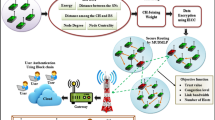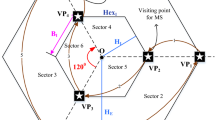Abstract
Wireless sensor network (WSN) comprises the interconnection of things or objects that are embedded with both hardware and software. The WSN is a tiny sensor with end device sensors that are connected to the Internet. To perform effective routing in the WSN efficient and reliable data collection, schemes are deployed with the routing protocol for low power and lossy networks (RPL) routing scheme for the low power and lossy network. The RPL routing scheme of the low and lossy routing protocol design for the network with the objective function. The objective function in RPL routing involved network construction and maintenance through hop count. The RPL scheme uses the destination-oriented directed acyclic graph (DODAG) with the greedy election for estimation of instability in the network. The routers in the WSN are enabled with the software-defined network (SDN) server node. The process of routing comprises detection of routes between the source and the destination. This paper focused on secure routing and monitoring schemes in WSN. To improve the secure routing process in WSN, this paper developed a deep RPL-software-defined network (DRPL_SDN). The DRPL_SDN concentrated on the parent selection through RPL based on the predicted energy level of the parent node. The prediction is performed with the DRPL_SDN-based reinforcement learning method with the estimation of child count through a partial stability routing mechanism. The secure prediction is performed through the deep reinforcement learning method in DRPL_SDN for the succeeded node count for the routing stability. The security model is evaluated with the utilization of the knowledge discovery in database (KDD) dataset. With the KDD dataset, the different attacks are evaluated in the proposed DRPL_SDN model. Additionally, the proposed DRPL_SDN exhibits better load balancing with the uncontrolled node in the network. The DRPL_SDN focused on the establishment of a link in the available network path through a dynamic controlled environment. The simulation analysis expressed that DRPL_SDN achieves the minimal packet loss of 236 and the energy consumption is minimal for 6%. The simulation examination expressed that the DRPL_SDN model exhibits the ~ 13% higher performance than the RPL and ELDR.












Similar content being viewed by others
Data availability
The data that has been used is confidential.
References
Nayak P, Swetha GK, Gupta S, Madhavi K (2021) Routing in wireless sensor networks using machine learning techniques: challenges and opportunities. Measurement 178:108974. https://doi.org/10.1016/j.measurement.2021.108974
Rajasoundaran S, Prabu AV, Routray S, Malla PP, Kumar GS, Mukherjee A, Qi Y (2022) Secure routing with multi-watchdog construction using deep particle convolutional model for IoT based 5G wireless sensor networks. Comput Commun 187:71–82. https://doi.org/10.1016/j.comcom.2022.02.004
Gite P, Shrivastava A, Krishna KM, Kusumadevi GH, Dilip R, Potdar RM (2021) Under water motion tracking and monitoring using wireless sensor network and Machine learning. Mater Today Proc. https://doi.org/10.1016/j.matpr.2021.07.283
Vanitha CN, Malathy S, Dhanaraj RK, Nayyar A (2022) Optimized pollard route deviation and route selection using Bayesian machine learning techniques in wireless sensor networks. Computer Netw 216:109228. https://doi.org/10.1016/j.comnet.2022.109228
Ding Q, Zhu R, Liu H, Ma M (2021) An overview of machine learning-based energy-efficient routing algorithms in wireless sensor networks. Electronics 10(13):1539. https://doi.org/10.3390/electronics10131539
Gupta N, Vaisla KS, Kumar R (2021) Design of a structured hypercube network chip topology model for energy efficiency in wireless sensor network using machine learning. SN Comp Sci 2(5):1–13
Gupta N, Jain A, Vaisla KS, Kumar A, Kumar R (2021) Performance analysis of DSDV and OLSR wireless sensor network routing protocols using FPGA hardware and machine learning. Multimedia Tools Appl 80(14):22301–22319
Rajpoot V, Garg L, Alam MZ, Parashar V, Tapashetti P, Arjariya T (2021) Analysis of machine learning based LEACH robust routing in the Edge Computing systems. Comp Electrical Eng 96:107574. https://doi.org/10.1016/j.compeleceng.2021.107574
Revanesh M, Sridhar V (2021) A trusted distributed routing scheme for wireless sensor networks using blockchain and meta‐heuristics‐based deep learning technique. Trans Emerg Telecommun Technol 32(9):e4259. https://doi.org/10.1002/ett.4259
Banerjee A, Mitra A, Biswas A (2021) An integrated application of IoT‐based WSN in the field of indian agriculture system using hybrid optimization technique and machine learning. In: Agricultural Informatics: Automation Using the IoT and Machine Learning, pp 171–187. https://doi.org/10.1002/9781119769231.ch9
Mittal M, de Prado RP, Kawai Y, Nakajima S, Muñoz-Expósito JE (2021) Machine learning techniques for energy efficiency and anomaly detection in hybrid wireless sensor networks. Energies 14(11):3125. https://doi.org/10.3390/en14113125
Lakshmi Narayanan K, Santhana Krishnan R, Golden Julie E, Harold Robinson Y, Shanmuganathan V (2021) Machine learning based detection and a novel EC-BRTT algorithm based prevention of DoS attacks in wireless sensor networks. Wireless Personal Commun, pp 1–25.
Ahmad R, Wazirali R, Abu-Ain T (2022) Machine learning for wireless sensor networks security: an overview of challenges and issues. Sensors 22(13):4730. https://doi.org/10.3390/s22134730
Amutha J, Sharma S, Sharma SK (2021) Strategies based on various aspects of clustering in wireless sensor networks using classical, optimization and machine learning techniques: Review, taxonomy, research findings, challenges and future directions. Comp Sci Rev 40:100376. https://doi.org/10.1016/j.cosrev.2021.100376
Upreti K, Kumar N, Alam MS, Verma A, Nandan M, Gupta AK (2021) Machine learning-based Congestion Control Routing strategy for healthcare IoT enabled wireless sensor networks. In: 2021 Fourth International Conference on Electrical, Computer and Communication Technologies (ICECCT), pp 1–6. IEEE, New York. https://doi.org/10.1109/ICECCT52121.2021.9616864
Raut AR, Khandait SP, Chavhan N (2021) QoS Aware machine learning algorithms for real-time applications in wireless sensor networks. In: Advances in automation, signal processing, instrumentation, and control, pp. 2665–2673. Springer, Singapore.
Raut AR, Khandait SP, Dongre SS (2021) A machine learning based mission critical data transmission protocol in wireless sensor networks. In: 2021 6th international conference on communication and electronics systems (ICCES) (pp. 846–852). IEEE, New York. https://doi.org/10.1109/ICCES51350.2021.9489013
Yu Q, Xiong F, Wang Y (2022) Integration of wireless sensor network and IoT for smart environment monitoring system. J Interconnection Netw 22(Supp02):2143010. https://doi.org/10.1142/S0219265921430106
Hussain ME, Hussain R (2021) Integration of machine learning techniques in virtual wireless sensor network for insect monitoring. J Phys Conf Series 1998(1):012031. IOP Publishing. https://doi.org/10.1088/1742-6596/1998/1/012031
Srividya P, Devi LN (2022) An optimal cluster & trusted path for routing formation and classification of intrusion using machine learning classification approach in WSN. Global Trans Proc. https://doi.org/10.1016/j.gltp.2022.03.018
Premkumar M, Sundararajan TVP (2021) Defense countermeasures for DoS attacks in WSNs using deep radial basis networks. Wireless Pers Commun 120(4):2545–2560
Acknowledgements
The authors extend their appreciation to the Deanship of Scientific Research at King Khalid University, Abha, Kingdom of Saudi Arabia, for funding this work through Large Groups RGP.2/170/1444.
Author information
Authors and Affiliations
Corresponding author
Ethics declarations
Conflict of interest
The authors declare that they have no known competing financial interests or personal relationships that could have appeared to influence the work reported in this paper.
Additional information
Publisher's Note
Springer Nature remains neutral with regard to jurisdictional claims in published maps and institutional affiliations.
Rights and permissions
Springer Nature or its licensor (e.g. a society or other partner) holds exclusive rights to this article under a publishing agreement with the author(s) or other rightsholder(s); author self-archiving of the accepted manuscript version of this article is solely governed by the terms of such publishing agreement and applicable law.
About this article
Cite this article
Qamar, S. Optimal sensor network routing with secure network monitoring using deep learning architectures. Neural Comput & Applic 35, 19039–19050 (2023). https://doi.org/10.1007/s00521-023-08753-0
Received:
Accepted:
Published:
Issue Date:
DOI: https://doi.org/10.1007/s00521-023-08753-0




